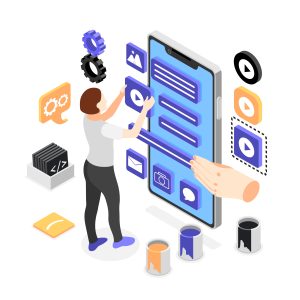Mobile App Development Made Easy in 10 Steps
Master the mobile app development process in 10 steps—from idea to launch, testing, and scaling—for beginners and aspiring pros.
Blog Overview
- Idea Generation & Market Validation in Mobile App Development
- Feature Planning & Listing for Successful Apps
- UI/UX Design That Wins Users in Mobile Apps
- Choosing the Right Technology Stack for Your App
- Building Frontend & Backend Efficiently
- Testing & Quality Assurance in Mobile App Development
- Launching Your App on App Stores
- Maintenance & Updates After Launch
- Monetization & Analytics for Mobile App Success
- Scaling & Growth Strategies in Mobile App Development
- Conclusion
- Let’s Build Your App Together (CTA)
- FAQs
Introduction
Mobile app development is booming, generating billions and offering massive opportunities for inclusive growth.
Did you know mobile apps generated over $935 billion in revenue in 2024? And it doesn’t stop there, the mobile market is projected to reach $613 billion by 2025 and hit a $330.6 billion overall market size in the same year. That’s not just growth, it’s a massive opportunity. Today, the mobile app development process is changing how we work, shop, and connect. For founders and businesses alike, building an app isn’t just a smart idea, it can be a game-changing move.
But honestly, where do you start? How do you make the right choices and not waste money or time?
This step-by-step guide walks you through everything, from turning your idea into reality to launching and growing your app. Whether you’re starting fresh or improving an existing one, you’ll get clear direction, proven steps, and the right tools, all in one place. And yes, we’ve made it simple, structured, and totally stress-free.

What You’ll Learn
This guide deconstructs 10 fundamental steps to excel at mobile app development, ranging from idea validation and feature planning to design, tech stack choice, development, testing, launch, and scale.
Every step provides you with a clear, actionable guide to create and develop your app confidently, either from scratch or enhancing an existing one.
Step 1: Idea Generation & Market Validation in Mobile App Development
Every successful app starts with a solid idea. But is your idea actually needed?
The first step in mobile app development for beginners is to decide on a real problem your app will address. Then, validate it with real users. You can run surveys, analyze competitors, and check trending keywords. Visit Google Trends or Quora to figure out what demographic is struggling with the most. Try to find the blank spots in the marketplace, not only the fad products everybody buys.
If you validate your idea, you will be certain that people want your app. Therefore, you are ahead of the thousands of apps that never book even one download. Idea validation is a key part of the mobile app development process that ensures you are solving a real user need.
Step 2: feature listing and planning
You have now proven the value of your idea, and you should move forward by building the tool to help. Logical thinking is all you need, since you don’t have to be a technology expert. List the core features your app must have to solve the main problem. These are your MVP ( Minimum Viable Product) features. Add a few nice-to-have options that you can build later. Planning early reduces waste and keeps the mobile app development process focused.
Consider it like preparing for a journey: start with the essentials first. As your app grows, you can always add more later. You select only the basics you need to set up your life. As your app grows, you can always expand later. Feature planning is the blueprint stage of the mobile app development process, setting the path for everything that follows.
Step 3: UI/UX Design That Wins Users
First impressions matter. Your app’s design can either attract or push users away.
Use simple layouts. Stick to common design patterns that people already understand. Make sure you use user-friendly app design tips designed for both Android and iOS. For Android, follow Material Design guidelines which prioritize clear navigation and responsive touch targets. For iOS, follow Apple’s Human Interface Guidelines which prioritize simplicity and natural interactions. You can make wireframes and mockups with Figma or Adobe XD without coding.
Test your app flow with a few users before development. Their feedback will reveal confusing parts or missing features. For mobile apps to do well in tough markets, the interface must be easy to use and attractive. Clean design and user flow are essential components of a great mobile app development process.
Step 4: Choosing the right technology stack
Selecting the right tool is similar to picking the foundation because it supports everything else.
For the best performance, pick Swift if you are developing for iOS and Kotlin for Android. Want to work economically and efficiently? Choose cross-platform frameworks like Flutter or React Native. They let you build one app that runs on both systems.
You’ll also need backend services. Firebase, Node.js, or Django are all reliable. Select a stack that matches your team’s skills and future goals. This decision impacts speed, flexibility, and maintenance in your mobile app development process. Consider cross-platform mobile app tools if budget or time is limited. Highlighting the benefits of such tools is essential in modern mobile app development process.
Step 5: Build the App: Frontend and Backend
You begin to build the essential features of your app at this time.
What users see and use on a website is called the frontend. The backend handles data, login systems, and server communication. Both need to work together smoothly.
Use agile development sprints. Break the process into weekly tasks. Test early and often. Build one feature at a time. Slow and steady progress is better than making mistakes because you’re in a hurry.
Pro Tip:
Develop one feature thoroughly before moving on to the next, reducing errors and rework.
Working with WhiterApps means getting professional support, good code practices, and frequent progress info, vital for a smooth mobile app development process. Their team has expertise in both frontend and backend, streamlining your build process.
Step 6: Testing the Prototype and Checking Its Quality in Mobile App Development
No user likes using an app that is full of bugs. Before launch, test everything from logins and navigation to form fields and crash scenarios. Manual testing helps catch what automated tools might miss. Check if the game runs well on actual hardware, besides using emulators.
Mobile app testing strategies unit testing, UI testing, and user testing are all part of quality assurance (QA). Apps with solid QA processes gain more trust and fewer negative reviews. Tests like your app’s reputation depend on it because it does. Quality assurance has a crucial place in the life cycle of mobile app development process.
Step 7: Development and App Store Launch in Mobile App Development
The work is done by you. You are ready to go live now.
Then, check and prepare your app for submission by ensuring you:
- Write an interesting and engaging description for your app.
- Use top-quality screenshots that highlight key features.
- Include a clear and transparent privacy policy.
- Design an app icon that stands out and is unique from others.
Upload the app onto Google Play or the Apple App Store when it is fully prepared. Because each business handles approvals in its way, stick to their steps. Even a small mistake often leads to a delay in the launch.
Get others involved to pick up any problems found during the end stages of development. Thanks to what the professional team says, the final version is improved before people see it. Don’t forget to apply app store optimization techniques to improve discoverability.
Step 8: After the App is Launched, Maintenance and Updates Are Necessary
Believing that publishing your app is when the work ends? It’s not even on the same level as energy sources.
After your app is launched, you still need to correct any errors, evaluate how things are running, and take user feedback. Update the app frequently to stay current and competitive. Regular improvements show users you care and reduce churn.
Crash reports, analytics, and app store reviews offer valuable insights. Use them to guide your next updates. A well-maintained app can grow steadily and stay competitive. Apps that survive long-term never stop improving. This is a key mindset in mobile app development for beginners and pros alike.
Step 9: Monetization and Analytics in Mobile App Development
Your app is live and stable. Now it’s time to earn from it. Choose a monetization model that fits your app’s audience. Ads, subscriptions, or in-app purchases are all valid options. Just don’t overdo it. For instance, excessive invasive ads or persistent notifications can annoy users and degrade the experience.
Use analytics tools like Firebase and Mixpanel to track user behavior. See which features they love and where they drop off. This data aids you in making smart and user-focused improvements that result in growth and income.
Planning for monetization should be included right from the start of creating the app. Long-term mobile app development process success depends heavily on sustainable monetization models and actionable analytics.
Step 10: Steps to Help Your App Gain Momentum in Mobile App Development
Scaling your app effectively will be needed if it gathers a large audience. Optimize your backend to handle more users. Use cloud infrastructure like AWS or Google Cloud. Monitor server health and app speed. Lag kills user engagement.
As you grow, think about new markets, languages, or platforms. Add new features only when they bring real value. Scaling isn’t just about adding more, it’s about growing wisely.
WhiterApps helps you not just build apps, but grow them sustainably with performance in mind. Growth and scalability are the final mile of mobile app development, ensuring long-term engagement.
Conclusion
Building a mobile app doesn’t have to feel overwhelming. When you follow these beginner-to-advanced steps, you stay in control. You start with clarity, build smart, and launch with confidence.
From idea to scaling, each step matters. And when done right, your app can change how people live, work, or play. Mastering the mobile app development process is a journey that pays off with the right plan and execution.
Let’s Build Your App Together
You have the idea. We have the expertise.
At WhiterApps, we design, develop, and launch high-quality mobile app development solutions tailored to your vision. Whether you’re a startup or an enterprise, we’re your partner in digital success.
Stay connected. Working together is essential for achieving something outstanding.
FAQs
Q1: What should I focus on at the start of mobile app development without experience?
Try to learn Kotlin, Swift, or Dart as your first programming language. Then create applications with basic features to practice your development and learn the basics of the mobile app development process.
Q2: Is Native or Cross-Platform development better?
Native offers better performance and integration, while cross-platform saves time and cost. Choose based on your project needs and career goals. Consider cross-platform mobile app tools if budget is a constraint.
Q3: An app task requires how many days or months?
Most of the mobile app development process tasks do not require less than 3 months or more than 6 months. The outcome will depend on the size, features, and your team’s working speed.

